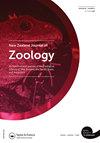库克海峡点击甲虫在新西兰Te Pākeka/Mud岛的分布、密度和栖息地协会
IF 1.1
4区 生物学
Q3 ZOOLOGY
引用次数: 0
摘要
摘要库克海峡点击甲虫(Amychus granculus)仅在新西兰五个近海岛屿避难所发现。我们使用标记重新捕获方法估计了Te Pākeka/Mud岛采样区内它们的海拔分布、种群密度和栖息地关联。我们在2020年11月的七次夜间调查中标记并捕获了个体甲虫,并记录了一系列环境变量,以更好地了解它们的栖息地关联。我们的调查证实了岛上海拔范围内存在甲虫,但低海拔地区的种群密度似乎最高。根据重新捕获的数据,我们估计一个大的低海拔地块的平均密度为892只甲虫/公顷(95%置信区间:556–1620),其余地块的平均浓度为575只甲虫每公顷(95%可信区间:230–1960)。温度可能影响了夜间甲虫的活动,因此也影响了捕获概率。栖息地评估表明,桃花树(Melicytus ramiflorus)的丰富程度以及树洞或岩石区的日间避难所对甲虫数量产生了积极影响。我们的研究结果首次为这种特有物种提供了可靠的种群估计。我们观察到的明显的不均匀分布模式及其与环境变量的可能联系有可能为保护管理提供信息,包括库克海峡点击甲虫未来迁移到存在合适栖息地的无捕食者地点。本文章由计算机程序翻译,如有差异,请以英文原文为准。
Distribution, density and habitat association of the Cook Strait click beetle (Amychus granulatus Coleoptera: Elateridae) on Te Pākeka/Maud Island, New Zealand
ABSTRACT The Cook Strait click beetle (Amychus granulatus) is found only in five offshore island refugia in New Zealand. We estimated their elevational distribution, population density, and habitat associations within sampling plots on Te Pākeka/Maud Island using mark-recapture methods. We marked and recaptured individual beetles during seven nightly surveys in November 2020 and recorded a range of environmental variables to better understand their habitat associations. Our surveys confirmed the presence of beetles across the island's elevational range, but population densities appeared highest at lower elevations. Based on recaptures, we estimated a mean density of 892 beetles/ha (95% CI: 556–1620) in one large, low-elevation plot and 575 beetles/ha (95% CI: 230–1960) across the remaining plots. Temperature may have affected nightly beetle activity, and hence also capture probability. Habitat assessments suggest the abundance of mahoe (Melicytus ramiflorus), and daytime refugia in tree cavities or rocky areas positively affected beetle counts. Our results provide the first robust population estimates for this endemic species. The apparent patchy distribution pattern we observed and its possible link to environmental variables have the potential to inform on conservation management including future translocations of Cook Strait click beetles to predator-free locations where suitable habitat exists.
求助全文
通过发布文献求助,成功后即可免费获取论文全文。
去求助
来源期刊
CiteScore
2.80
自引率
0.00%
发文量
20
审稿时长
>12 weeks
期刊介绍:
Aims: The diversity of the fauna of the southern continents and oceans is of worldwide interest to researchers in universities, museums, and other centres. The New Zealand Journal of Zoology plays an important role in disseminating information on field-based, experimental, and theoretical research on the zoology of the region.

 求助内容:
求助内容: 应助结果提醒方式:
应助结果提醒方式:


